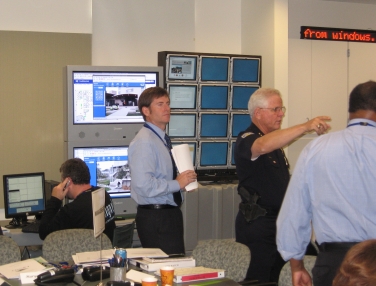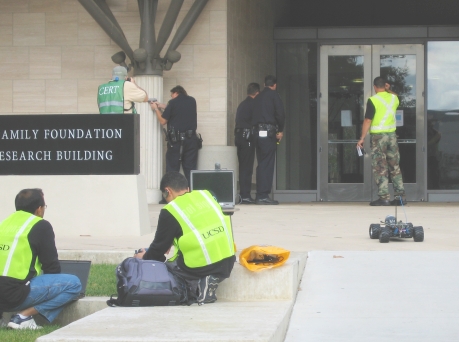Calit2 Technologies Demonstrated During UCSD Campus Drill
By Maureen C. Curran
|
San Diego, CA, October 30, 2007 -- Before the campus closure last week due to poor air quality caused by multiple large wildfires in the San Diego region, UCSD conducted an emergency response exercise on October 16, to prepare for, and test campus emergency readiness. This full-scale exercise was based on an active-shooter scenario.
During the drill, Calit2 researchers from the RESCUE and ResponSphere projects successfully demonstrated nearly a dozen new technologies which support emergency and disaster response.
"We find ourselves in the crossroads of a number of things that have to do with disaster response," said Ramesh Rao, director of the UCSD division of Calit2, during the exercise debriefing. Rao, a principal investigator (PI) on the RESCUE project and co-PI for ResponSphere, thanked the campus organizers, especially Phillip Van Saun, the manager of UCSD's Emergency Services: "for giving us a chance to get out of the labs and really see how an emergency scenario unfolds and how these technologies make a difference."
Tight integration among the multiple technologies was showcased and tested for the first time in a full-scale drill. The Rich Feeds system simultaneously captures numerous data feeds for dissemination and archiving, either in real time or after the fact. Multiple streams of information from the scene were sent to the Rich Feeds system and successfully displayed in the emergency operations center (EOC), which was located at the UCSD police department, across campus from the scene.
|
A Gizmo truck (off-the-shelf remote-controlled scale-model truck) adapted to be a mobile platform to deploy multiple technologies) was in operation at the scene, close to the areas of activity. It provided two feeds to the system: one which tracked its location on a map and another which was a live video feed from a camera mounted on it. Gizmo's mobility allows it to be moved with the action.
To enable the Rich Feeds system to receive these feeds, a Wi-Fi ‘bubble´ was created at the scene using CalMesh, an ad-hoc network of small, lightweight and easily deployable access-point boxes (in this case four). The CalMesh network connected to the UCSD network, which was available in the EOC.
A Non-Uniform Tile System OptIPortal (NUTSO) display was set-up in the EOC. NUTSO is a command-and-control display wall of twelve tiled standard-size laptop monitors and two large television displays; each monitor can be used independently or in concert with any number of the others. NUTSO displayed real-time video and data feeds from Gizmo, two other cameras and several research applications ongoing at the scene.
|
The UCSD Chief of Police, Orville King, was the incident commander; he and others in the EOC also made use of NUTSO, requesting that campus maps and floor plans be displayed as well as feeds from campus cameras. With 14 monitors available, all streams and screens were simultaneously available.
"What is really good is that in San Diego, we have a joint response, a unified command with UCSD Police, San Diego Police and Fire," said King, "We were able to respond with composite teams, San Diego and UCSD police went in together." In a similar vein, the success of these new technologies supporting emergency response is the result of Calit2 working closely with first responders from the start and continuing to do so throughout the development and testing process.
In concluding her comments at the debriefing, UCSD Chancellor Marye Anne Fox summed things up: "When we work together, the result is something we can be very proud of. [This drill] will increase the confidence of the campus that it has done the right things, and is ready to do the right things when it's no longer a test, but a real emergency."
Related Links
Drill Photo Gallery




